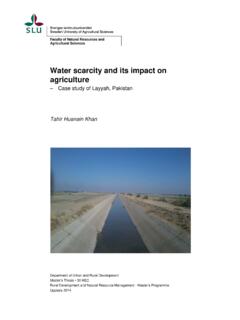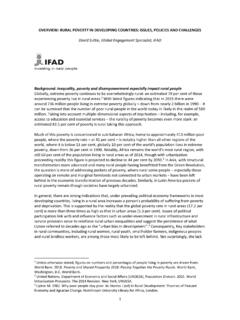Transcription of Chapter 2. Latin American Agriculture: Prospects and ...
1 70 2. Latin American agriculture : Prospects AND CHALLENGES OECD-FAO AGRICULTURAL OUTLOOK 2019-2028 OECD/FAO 2019 Chapter 2. Latin American agriculture : Prospects and Challenges This Chapter reviews the Prospects and challenges facing the agricultural sector in Latin America and the Caribbean (LAC). The region accounts for about a quarter of global exports in agricultural and fisheries products, underscoring the importance of trade openness at the global level. Strong growth opportunities in high value fruit and vegetable crops provide opportunities for smallholders, but policies will need to be differentiated according to resource endowments and market potential. Food security continues to be a concern, with many households unable to afford the food they need. Given the simultaneous rise in the number of people who are overweight and obese, several initiatives seek to counter these trends. Raising agricultural productivity sustainably in LAC will rely on new strategic investments in agriculture s enabling environment.
2 However, due to the region s diverse state of rural infrastructure, R&D initiatives and of environmental problems from agricultural production, mixed potential exists to further expand public spending and improve the environmental performance of the sector. 2. Latin American agriculture : Prospects AND CHALLENGES 71 OECD-FAO AGRICULTURAL OUTLOOK 2019-2028 OECD/FAO 2019 Introduction The Latin America and Caribbean (LAC) region covers more than 2 billion ha and encompasses 34 countries with a total estimated population in 2018 of 657 million- a low average population density of persons per ha. From the available area, 38% is used for agriculture ( for crops and for pasture) and the other 46% is covered with forests. The region s land represents 15% of the earth's surface, receives 30% of precipitation and generates 33% of the world's water, which makes the region a great world reserve of arable land and forests.
3 Due to its enormous latitudinal range, varied topography and rich biodiversity, LAC has one of the most diverse and complex range of farming systems of any region in the world (Box ). agriculture is an important sector for the economy across much of LAC, accounting for an average of of GDP in 2015-17. This share is lower than in 1996-98, in line with traditional economic development trends, and reflects declining shares in all LAC countries except Argentina. Some countries have seen agriculture s share in total GDP reduced drastically such as Ecuador (10% during the same period), Guatemala ( ) and Guyana ( ). Nevertheless, agriculture still accounts for around 10% or more of total GDP in these countries, as well as in Belize, Bolivia, Dominica, Ecuador, Haiti, and Paraguay. agriculture and fisheries in Latin America and the Caribbean have grown by an average of per year (in constant 2010 US dollars, including forestry) over the past two decades, a slightly lower rate than overall economic growth, commensurate with the sector s declining share of GDP.
4 This pace of growth is considerably faster than that of OECD countries ( annual growth), but slower than that of the more dynamic regions of South Asia, and East Asia and the Pacific, which grew by and respectively, or Sub-Saharan Africa, which outperformed every region by growing at per year (World Bank, 2019[1]). Performance has been diverse across the region. In general, agriculture and fisheries in South American countries have performed relatively better than in Central American countries. The sector has contracted in several Caribbean economies, yet the second fastest rate of growth ( ) was recorded in the Dominican Republic. The region has positioned itself as a leading exporter of agricultural products. Latin American countries are major exporters of soybeans, pork, maize, poultry, animal feed, sugar, coffee, and fruits and vegetables. Brazil is the largest agricultural and food exporter (USD billion in 2017) in the region, followed by Argentina, (USD billion), Mexico (USD billion), Chile (USD 17 billion), Ecuador (USD billion) and Peru (USD billion).
5 Some Latin American countries are significant importers of agri-food products as well, such as Mexico, which is among the major world importers of maize, soybeans, dairy, pork and poultry, and Brazil, one of the top world wheat importers. Overall, however, LAC s agricultural trade surplus has steadily increased over the past two decades, reaching USD billion in 2017. The sector is especially important to livelihoods. In 2018, of total labour force in the LAC region was employed in agriculture . Countries such as Bolivia, Ecuador, Guatemala, Honduras, Haiti, Guatemala, Nicaragua and Peru employed more than a quarter of its labour force in the agricultural sector (World Bank, 2019). LAC countries managed to bring rural poverty rates down even during times of economic crises and sluggish economic growth. From 1990 to 2014, rural poverty in the region fell by almost 20 percentage points.
6 Key to this successful performance was a switch in public policy from generalised consumer subsidies to targeted conditional cash transfer programmes, 72 2. Latin American agriculture : Prospects AND CHALLENGES OECD-FAO AGRICULTURAL OUTLOOK 2019-2028 OECD/FAO 2019 where Latin American countries have been pioneers. Moreover, during times of economic crises in the region, agriculture has served as a buffer during recessionary periods (Arias et al., 2017[2]). The favourable poverty alleviation trend, however, has been reversed in recent years. Furthermore, there is still a high incidence of poverty and extreme poverty in rural areas ( and , respectively). Since 2015, the trend of closing the gap between the rural and urban poor has also reversed, and the poverty gap has widened when other dimensions of poverty (access to basic public services) are taken into consideration (CEPAL, 2018[3]; Food and agriculture Organization of the UN (FAO), 2018[4]).
7 In addition, the number of undernourished people increased for the third consecutive year in 2017, reaching million in (Food and agriculture Organization of the UN (FAO) et al., 2018[5]), a problem related to the affordability of food to poor consumers rather than the physical availability of food, given the agricultural and food surplus status of the region. LAC s abundant natural resource endowment will allow the region to continue playing a major role in world agricultural production and trade. The challenges for the future lies in maintaining growth in a context of slower demand growth and lower international prices, while ensuring that future agricultural growth is more sustainable and more inclusive than it has been in the past. Box agriculture in Latin America and the Caribbean a vastly heterogeneous sector agriculture in Latin America and the Caribbean (LAC) is heterogeneous from nearly every angle. The region covers a great variety of different agro-ecological zones, varied topography and vastly different farm sizes and structures, operating at different levels of technology and sophistication.
8 This makes agriculture in the region immensely diverse in terms of production systems, economic importance and its contribution to income, employment and trade. The region s overall productive structure is highly diverse. A capital and technology-intensive corporate sector that has successfully managed to integrate itself into global agri-food markets alongside coexists alongside a broad socio-productive sector based on subsistence farming, non-farming rural activities and landless rural populations that have been unable to participate in dynamic economic circuits. Between these two extremes, there is an intermediate sector that is able to connect to markets, but that continues to be extremely vulnerable to economic and political shocks as well as to climatic risks. The heterogeneity of agriculture in LAC is reflected in the diversity of the region s farm structures. While agriculture in the Southern Cone is dominated by large, commercial and export-oriented farms, particularly in Argentina and Brazil but increasingly in other countries such as Uruguay, much of the rest of the region is characterised by smallholder and family agriculture .
9 It is estimated that there are 15 million smallholder and family farmers in the LAC region, who are responsible for a substantial share of the region s food production. As regards trade, while the region as a whole is a major supplier of grains and oilseeds to global markets, as well as bananas, coffee and sugar, large differences exist across the sub-regions. For instance, the countries of the Southern Cone, in particular Argentina and Brazil, are among the world s largest exporters of wheat, maize, soybeans and sugar, whereas the Caribbean countries depend on world markets to meet their food requirements. 2. Latin American agriculture : Prospects AND CHALLENGES 73 OECD-FAO AGRICULTURAL OUTLOOK 2019-2028 OECD/FAO 2019 There are also large differences in the contribution of agriculture to overall economic output. On average, primary agriculture merely accounts for less than 5% of GDP in LAC, but the regional average masks considerable differences across countries.
10 While agriculture accounts for even less than 4 % of GDP in Mexico and Chile, it exceeds 15% in Belize and Nicaragua and even 20% in Paraguay. Nevertheless, regardless of the individual country situation, the importance of agriculture rises when upstream and downstream activities are added to primary production. Applying this broader definition of agriculture , the sector accounts for a share of more than 20% of GDP in most of the LAC economies. Agricultural development Agricultural performance The Latin America and Caribbean region has experienced substantial agricultural output growth over the past two decades. Brazil was one of the agricultural growth leaders both in the region and worldwide, with an average growth rate of between 1991 and 2015, while Southern Cone1 and Andean countries agriculture grew , Central American agriculture grew , and Caribbean countries reported a modest average annual growth rate. Most of this production growth has come from productivity improvements, rather than bringing more land into production.














